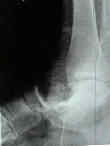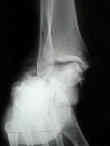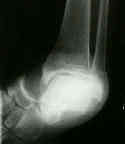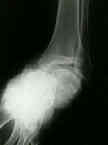- See: Sub-Talar Joint
- Discussion:
- involves dislocation of distal articulations of talus at both talocalcaneal & talonavicular joints;
- ankle joint is undisturbed;
- distinguish between medial and lateral subtalar dislocation;
- method of reduction is different w/ each type
- long term prognosis appears to be worse with lateral dislocation;
- associated injuries:
- Osteochondral Lesions of Talus;
- Ankle Frx;
- Frx Base of 5th Metatarsal;
- Navicular and Cuboid Fractures;

 - Anatomy:
- Anatomy:- lateral dislocation anatomy:
- less common type of subtalar dislocation (15%);
- calcaneus is displaced lateral to talus;
- talar head lies medially, and foot appears pronated;
- navicular lies lateral to the talar neck;
- lateral dislocations may be complicated by interposed posterior tibial tendon (or sometimes FDL);

 - Anatomy:
- Anatomy:- medial dislocation anatomy:
- most common sub talar dislocation (85%);
- foot & calcaneus are displaced medially;
- head of the talus prominent dorsolaterally;
- navicular lies medial and sometimes dorsal to talar head & neck;
- foot is plantar flexed and is supinated;
- inversion causes this injury;
- called "basket ball foot" since it is a common mechanism;
- Non Operative Rx:
- closed reduction is facilitated w/ knee flexion to relax the gastroc;
- follow up CT scan to rule out osteochondral lesions & to assess reduction;
- Operative Indications and Treatment:
- medial dislocations:
- approx of 10% of medial dislocations require open reduction;
- capsule of talonaviclar joint & EDB blocks reduction, or in some cases the talar head may button hole thru the EDB;
- medial sub talar dislocations are treated by longitudinal anteromedial incision over prominent head and neck of talus & minipulation and release of interposed tissues;
- since the joint is stable after reduction there is no need for internal fixation;
- after reduction, a short leg cast is applied for 3 to 4 wks;
- lateral dislocations:
- approx 20% of lateral dislocations require open reduction;
- interposed posterior tibial tendon blocks reductions;
- incision over sinus tarsi, and three wks of NWB casting, followed by ROM;
- references:
Anatomical considerations of irreducible medial subtalar dislocation.
Obstacles to reduction in subtalar dislocations.
- Complications:
- infection:
- may occur in 30% of patients w/ open dislocations, despite aggressive I and D;
- w/ total talar extrusion, consider replacement w/ a semi-permanent spacer using antibiotic containing methylmethacrylate;
- avascular necrosis:
- see: AVN following talar frx:
- has been reported rarely after subtalar dislocation;
- because the talus is not disrupted from the ankle mortise, at least some of its blood supply remains intact
Severe open subtalar dislocations. Long-term results.
Subtalar dislocations of the foot.
Subtalar dislocations: long-term follow-up of 39 cases.
Open Subtalar Dislocation Treated by Distractional External Fixation.

